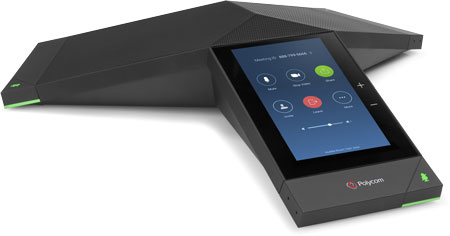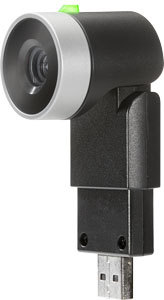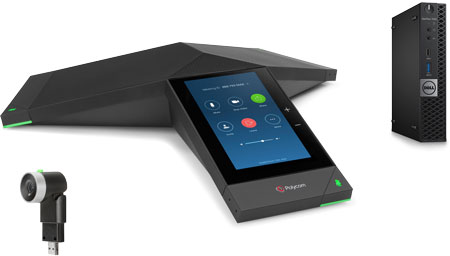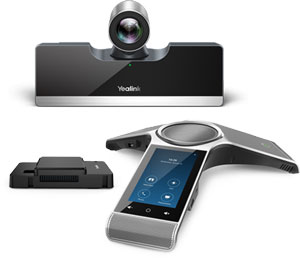Zoom Rooms is a cloud-based service that provides a complete conferencing experience for businesses of all sizes.
Zoom features HD video and audio conferencing, along with progressive features like wireless content sharing, remote participant integration, digital signage, and scheduling display.
Because Zoom is highly scalable, it works brilliantly for huddle rooms.
Huddle rooms are a primary location for workplace collaboration today. In a 2018 study, Frost & Sullivan estimated that 70% of all video conferencing meetings will take place in the huddle room in 2022.
Why are huddle rooms so popular?
As compared with the formal, large conference rooms of yesteryear, huddle rooms enable either scheduled or impromptu meetings with groups of people of a manageable size.
Workers are more engaged in smaller groups where their voices have more weight.
By having smaller, more focused groups, you increase productivity by eliminating the wasted time of forcing workers to be present at a meeting that doesn’t directly affect them.
In this blog, we’re going to give you clear advice on how to optimize the huddle room for Zoom.

Microphone & Speaker
The most important feature for a professional video conferencing experience is actually audio. While even poor webcams can give you a decent understanding of who’s who, if your microphone is poor you might not even be able to understand what anyone is saying.
With huddle rooms, you’re talking about meetings of up to 5 or 6 people at most, so you don’t need to worry as much about power and reach and expansion microphones.
Instead you need to think about two features:
- Voice clarity
- Noise reduction
Voice clarity
Look for microphones that offer wideband or HD audio – or better. Wideband audio means more of the audio spectrum is being picked up and relayed.
By having more of the spectrum, voices sound more natural. Studies have shown that having a more natural sounding voice improves comprehension and reduces misunderstandings.
Noise reduction
Reduce background noise as much as possible. There are two questions you need to ask:
- How much ambient noise (e.g. AC, heating) is there?
- How well can you hear people talking in the background?
Many enterprise microphones incorporate noise cancellation. For example, Polycom Acoustic Fence uses beamforming microphones to delineate a virtual perimeter around a conversation, to blocking out sound beyond that perimeter. The result is a significant reduction in distractions.
If you have a huddle room in an open-plan office, people talking in the background will likely be a major issue.
Speaker
Of course, a microphone is no use without a speaker. Using a display’s built-in speaker is not enough, even though the huddle room, being smaller, doesn’t place heavy demands on the speaker.
You need a speaker with HD audio support. As with the microphone, look for wideband (or better) audio.
If you have a system with a conference phone, that will give you the professional audio quality you need. You might also consider a USB speakerphone for additional power.

Camera
While you could use an off-the-shelf webcam for video conferencing, for a professional conferencing experience, you should look for a professional video camera.
Mount the camera either on top of or below the display. On top is to be preferred, because the angle is more natural (and more flattering).
A wide-angle camera is typically appropriate for a huddle room. Why? There is less space in a huddle room, which means people will be closer to the display than in a standard conference room. If your camera’s field of view is too narrow, you might cut off people close to the display.
When selecting a video camera to use, consider the lighting in the huddle room. Most corporate offices and small businesses have rooms with strong lighting from above, often fluorescent. Here are some questions to ask:
- Does the room have strong lighting from above? Is it fluorescent? Are there windows that casts a strong horizontal light? Can you use shades to block out the light?
- Is the lighting dark?
- Does the light change people’s skin color? Do people look natural? Consider the color(s) of the wall(s), which can really change what people look like on camera.
If there are strong shadows or high-contrast lighting, look for a camera that supports wide dynamic range (WDR). WDR technology uses multiple exposures to greatly reduce under- or overexposure.
If you’re dealing with a dark room, look for a camera with a wide aperture. Having a wide aperture lets more light onto the video sensor, which means you get a better picture in lower light.
Many professional video cameras have automatic white balance , which can deal with the problem of lighting changing the color of people’s skin. But even with automatic white balance, you should test the system to ensure people are displayed naturally. If the balance is off, adjust it until the people look right.
Two camera technologies that greatly increase the natural feeling of video conferencing are becoming more common on the market:
- Group framing
- Speaker tracking
Group framing
Group framing means that the camera automatically interprets how many people there are in the conversation, then adjusts the picture frame to fit the group. The result is much less space of the picture frame wasted on walls or chairs. It also means that people will appear larger on the display, which lets people see body communications better.
Speaker tracking
Rather than frame the whole group, speaker tracking frames the active speaker. The camera uses directional microphones to determine who is speaking, and then it frames that person. The result is a natural flow to the conversation, making it much easier for far-end participants to follow who is talking.

Display
There are several questions to ask when choosing a display. For many applications, a consumer-grade display will suffice. However, Zoom Rooms supports interactive displays, which leads us to our first two questions:
- Do you want a touchscreen display?
- Do you want two displays?
Dual display is important if you want to show slides, presentations, or similar content.
If you want to display content, having a touchscreen display can be useful. Your team can collaborate in real time on documents or brainstorm together.
Zoom Rooms supports wireless content sharing from mobile devices and laptops, which means content sharing is very simple.
- Do you want a 4k Ultra HD display?
4k displays are getting less expensive by the day, but the technology for having live professional conferences in 4k UHD are only just coming out, because it places heavy demands on your network.
The advantage of 4k UHD is unparalleled detail, making the conferences that much more lifelike.
You might also consider an investment in 4k UHD today to futureproof your system.
- Will you need a VESA mount for mounting the camera?
Many camera display mounts use standard VESA mounting patterns for installation. Make sure your display fits the mount of your preferred camera.
Because there are many more satisfactory displays on the market than cameras, it’s easier to find a display to fit a camera than vice versa.
Scheduling Display
One amazing feature you get with Zoom Rooms is scheduling display.
Scheduling display allows you to place a tablet or small monitor at the door of the huddle room to show if the room is in use and for how long. It also lets you schedule your own meeting.
For busier offices where the huddle room is in demand, Zoom scheduling display is a significant differentiator.

Zoom Video Conferencing Systems
Zoom has partnered with leading manufacturers to design video conferencing systems optimized for Zoom.
These systems give you a native Zoom interface to provide a seamless experience and reduce teaching time.
Polycom Trio Zoom Rooms Huddle Room Kit
The Polycom Trio Zoom Rooms Huddle Room Kit includes a Trio 8500 conference phone, which means crystal-clear audio out to 14ft. It supports NoiseBlock and Acoustic Fence to reduce background noise.
You also get an EagleEye Mini camera, which is an ultra-compact USB camera with wide-angle lens. It takes 1080p Full HD video with true color saturation and rendering for excellent, lifelike detail.
The included Dell mini-PC has the Zoom Rooms software pre-installed.
Yealink CP960-UVC50 Zoom Rooms Small to Medium Room Kit
The Yealink CP960-UVC50 Zoom Rooms Small to Medium Room Kit includes a CP960 conference phone with Optima HD audio using a 360° 3-microphone array, as well as noise reducing technology.
It also includes a UVC50 camera with wide-angle lens and 1080p Full HD video support.
The included mini-PC comes with the Zoom Rooms app already installed, so it’s ready to go out of the box. It has an SSD hard drive and Intel Core i5 CPU, making it speedy and efficient.

